On Wednesday afternoon, more than fifty growers convened at the BASF | Nunhems greenhouse complex in 's-Gravenzande to get an update on the many trials the company is conducting there. One of these aims at getting the highest yield, and another trial looks at energy efficiency.
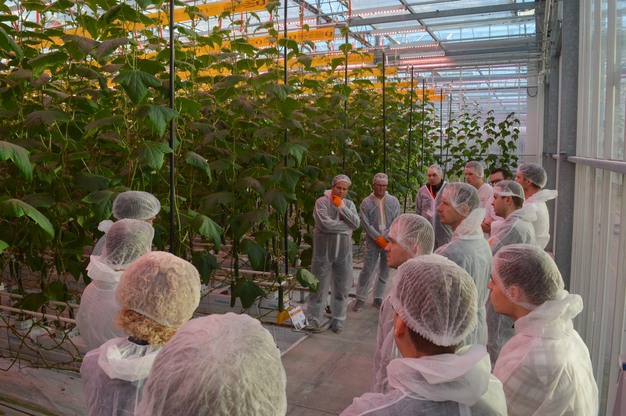
Marcel Huibers and Frans Goud provide an explanation on behalf of organizer BASF I Nunhems in the trial with a data-driven cucumber cultivation in 's-Gravenzande.
From three to two crops
Data-driven cultivation has been carried out for three years in a row in one of the compartments of the BASF greenhouse. This is fully equipped with LEDs, growers are trying to get the biggest yield using 340 micromoles of light, with 9% red light.
On October 18, the first crop was planted, with 2.5 plants per square meter. In the past two years, the growers chose a base temperature of 17 and 18, whereas now they are keeping a base temperature of 19 degrees Celsius with an RTR of 2.2-2.8. The goal is to keep the temp higher when light levels are lower and vice-versa, thus also improving the working conditions for greenhouse workers.
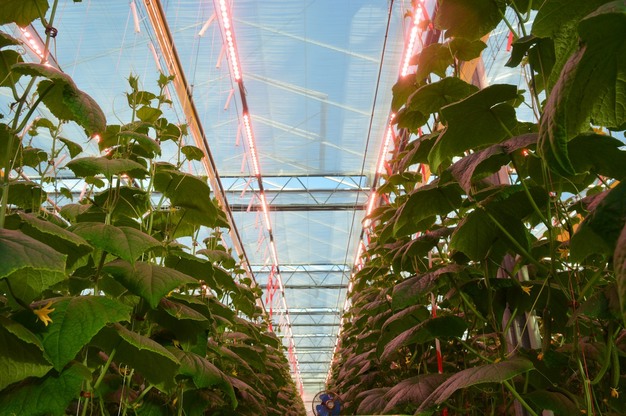
The greenhouse has a blackout screen and a 'fairly open screen.' In the summer, the cloth can remain closed, and there is still air exchange, but in winter, the greenhouse loses a little more heat than the growers want. "I'm actually half a degree short on my day degrees," grower Frans said about the situation in early December.
Trial goal: 450 pieces
The specific goal of the trial is to harvest 450 cucumbers. For the first trial, the target fruit weight is 380 grams, while in trial number 2, 400 grams is the target. The main varieties chosen in trial 1 are Hi-Light and Uptrace. In trial 2, these are Hi-Light and NUN 62014. A new variety with high virus and mildew resistance that will soon get a name, Rens Muusers announced during his presentation.
The Sales Specialist Cucumber was one of the three speakers during the Cucumber Event Light Up. In the greenhouse, Marcel Huibers, as Senior Product Development Agrotechnologist, spoke to the participants, who were divided into three groups, together with cultivation technician Frans Goud. At The Vineyard in Monster, Govert Trouwborst from Plant Lighting gave a presentation about a trial at Botany.
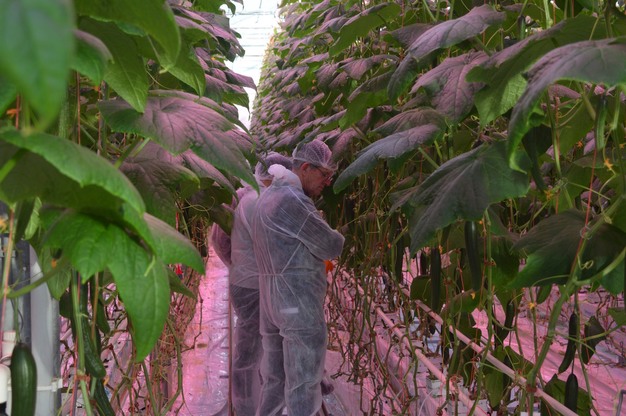
A look at the crop was not to be missed. Here is Herman Hermans from Innocrop Consulting. He is involved in the trial at Botany.
Lesson from the first two years
Marcel and Frans received several questions from the growers, who noted that the crop was in good shape in early December. Rens later said that this was somewhat less just before the growers' visit. The crop was a bit full of leaves. One of the takeaways is that a leaf can be removed from the head a bit faster.
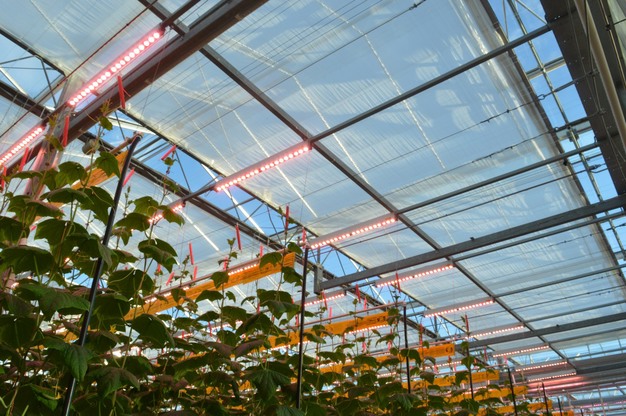 For optimal results, there is a missing fixture in the aisle. As a result, the plants along the path do not get the optimal light, Marcel acknowledged.
For optimal results, there is a missing fixture in the aisle. As a result, the plants along the path do not get the optimal light, Marcel acknowledged.
What is economical?
The presentation by Govert Trouwborst from Plant Lighting was about another pilot project on energy efficiency.
In the trial, co-funded by the Dutch government and thus with maximum limits for energy use, a group of companies has conducted research into the most energy-efficient winter cultivation of cucumbers possible. It is important to distinguish between economical in the sense of kilograms of energy per product or energy per square meter, Govert emphasized. The financiers of the project are interested in the latter.
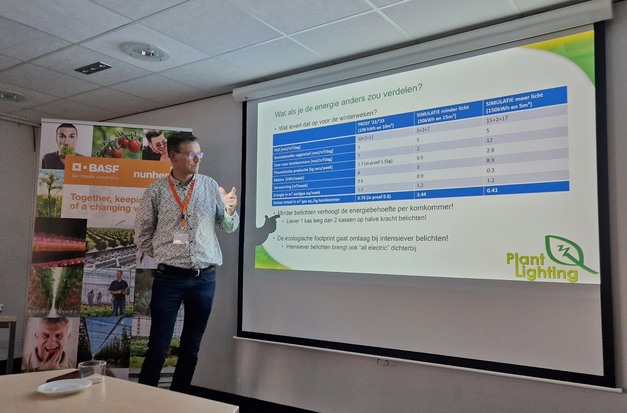
In Meterik, Limburg, 100-kilowatt hours of electricity (95 for lighting and 5 for an Air&Energy system) and 10 cubic meters of gas went into the cultivation. According to the light researcher, good screening was crucial. The new greenhouse also used an Air & Energy system, which also saved energy.
The trial in Meterik has been continued. A new cultivation started on October 16. The researchers have been looking at whether the energy efficiency of cucumber can be further reduced by distributing the total input of energy differently: relatively more light and less heat.
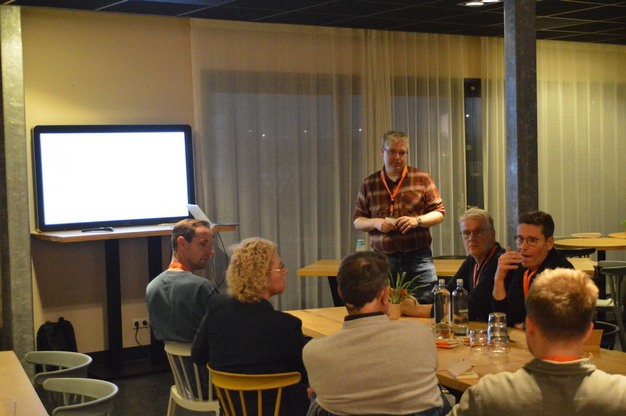 Rens Muusers discussed the data-driven cucumber cultivation of the past two years and looked ahead to this year's trial.
Rens Muusers discussed the data-driven cucumber cultivation of the past two years and looked ahead to this year's trial.
Govert looked ahead on Wednesday afternoon using simulations. He sees opportunities to cultivate with more light and even less gas. Pointing to figures, he advocates the use of more light up to a certain maximum. "Rather light one greenhouse to the maximum than half light two greenhouses." Nunhems chooses the maximum and sets the bar high in 's-Gravenzande. The plants receive a maximum of 30 mol per day. The plant cannot handle more light, as has been shown in previous cultivations.
The results of the trials will have to wait until 2024. In practice, growers also have the lights on more often above the cucumbers this winter. That was discussed during the drink and winter barbecue afterwards. Despite all the challenges, growers continue to look at what is possible.
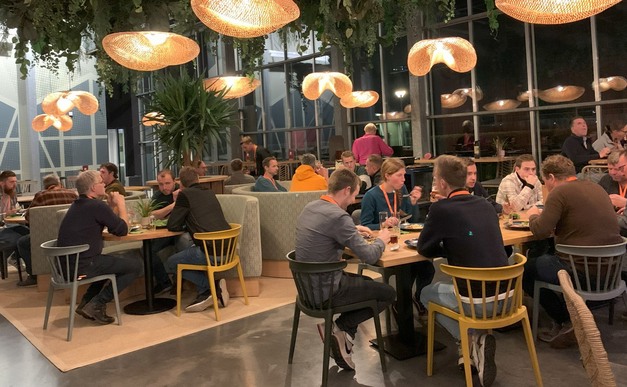
The concluding winter barbecue
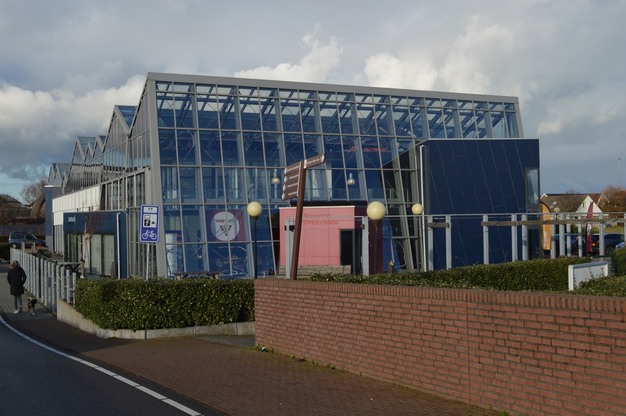
The Vineyard in Monster was where the afternoon was held
For more information: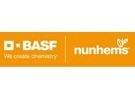
BASF I Nunhems
www.nunhems.nl
